NEW ALBANY HISTORY
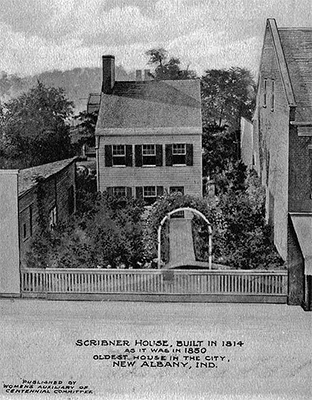 The buffalo, which left the Great Plains to visit the salt licks of Kentucky, came through what is now Floyd County and New Albany by the thousands. The trail they made is still plainly visible and was the basis for the first westward road from Louisville to Vincennes.
The buffalo, which left the Great Plains to visit the salt licks of Kentucky, came through what is now Floyd County and New Albany by the thousands. The trail they made is still plainly visible and was the basis for the first westward road from Louisville to Vincennes.
Starting with George Rogers Clark and his poorly equipped soldiers who gave the infant United States a claim to the vast Northwest Territory from the British, the Northwest Ordinance of 1787 created territory out of which Indiana emerged as a state. To this area came the Scribner brothers, Joel, Nathaniel and Abner in 1812-1813 from New York. The land below the Falls of the Ohio was chosen because of its potential for transportation, ship building, and other business.
Early in 1813, the first tree was felled to clear the land for what was to become New Albany. The first Scribner cabin was at East Sixth and Main streets; later in 1814, the present Scribner House (pictured) was built by Joel on the southeast corner of Main and State streets. Immediately, the ground for the new settlement was platted and named New Albany in honor of the capital of their home state, New York. In 1817 New Albany was incorporated as a town while still a part of Clark County. But thanks to the efforts of Nathaniel Scribner, Floyd County was recognized as a county in its own right in the spring on 1819. Cut out of Clark and Harrison counties it was named "Floyd" supposedly after Davis Floyd, a territorial politician and friend of Aaron Burr. Davis Floyd became the first judge in the county. The county itself is the second smallest count in land size in the State.
Prior to the building of the locks on the Louisville side of the river, New Albany was one of the largest cities in the middle west due to the influence of the river. In 1839, New Albany became incorporated as a city.
During this period of time, a man by the name of Epaphras Jones decided to found a town by the name of Providence at the foot of Vincennes Street. He hoped to establish a ferry at this locality to Louisville. Jones was not as careful in the mapping of a town as his New Albany neighbors who had carefully planned their land. When he finally became discouraged with his idea, the houses in Providence had straggled out to meet the upcoming New Albany residents. This accounts for the sharp curve at East Tenth Street from East Oak to East Spring streets.
Continue Reading
EARLY DEVELOPMENT OF NEW ALBANY
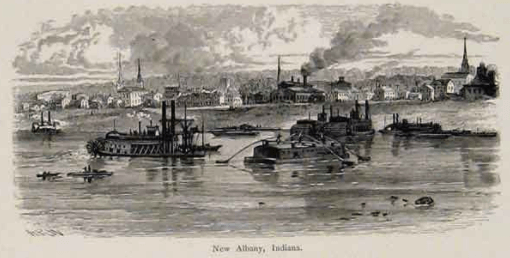
“This town is just laid out, with spacious streets, public squares, markets, etc. It is situated on the bank of the Ohio River, at the crossing place from Louisville to Vincennes, about two miles below the falls, in the Indiana Territory, and affords a beautiful and commodious harbor. The beauty of the prospect is not surpassed by ANY in the Western country…”
(This is part of an advertisement that the founders of New Albany; Joel, Abner and Nathaniel Scribner used to advertise their new town in 1813.)
Two years later there were 68 buildings located in the town including a post office, sawmill and gristmill. In 1818, New Albany constructed its first of many steamboats. And by 1850, and for almost 30 years, New Albany was the largest city in the state of Indiana, not only in population, but also in commerce and wealth! During this period of time, the downtown was home to numerous wholesale and retail establishments and fortunately, many of these business houses remain today in the Downtown New Albany National Register Historic District.
Continue Reading
THE INTERUBAN TO INDIANAPOLIS
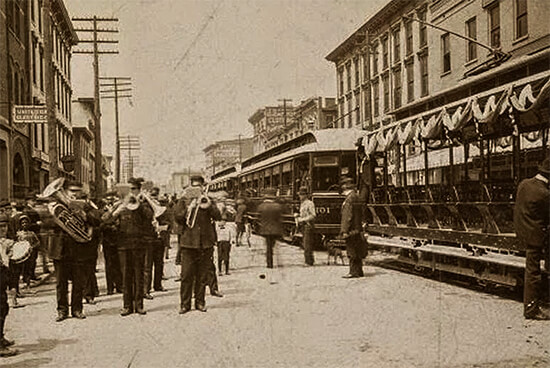
The sound of singing trolley wires announced its coming . . . then the faroff melodious tones of the air horn breaking the still night air . . . then the piercing gleam of the big headlight reflecting on the twin ribbons of rail as it came closer and then swept by with controller wide open – that was the “Hoosier Flier” flashing through the Indiana countryside in the days when the electric interurban line connected the Falls Cities and Indianapolis.
Continue Reading
THE LEGEND OF THE ROBERT E. LEE
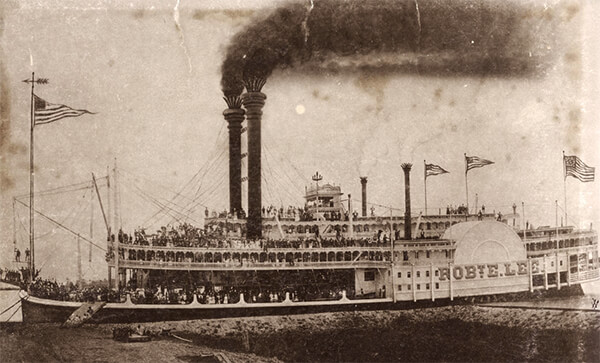
The Robert E. Lee Steamboat was nicknamed the "Monarch of the Mississippi" and built in New Albany, Indiana in 1866 for a price of $200,000. The grand steamboat was 297 feet by 49 feet. While the name was being painted on the ship it was moved over to the Kentucky shore as some Hoosiers resented the name of the rebel leader being used.
On June 30, 1870 the steamboat left New Orleans in a race against the Natchez to St. Louis. At the time the Natchez was the then-current speed record holder. The Henry Tate, MayFlower, Mary Alice and Tahlequah preceded the two steamboats up the river for a way with excursionists in order to be able to view the race. The Robert E. Lee won with the time of 3 days, 18 hours, 14 minutes.
Continue Reading
IRON WORKING IN NEW ALBANY
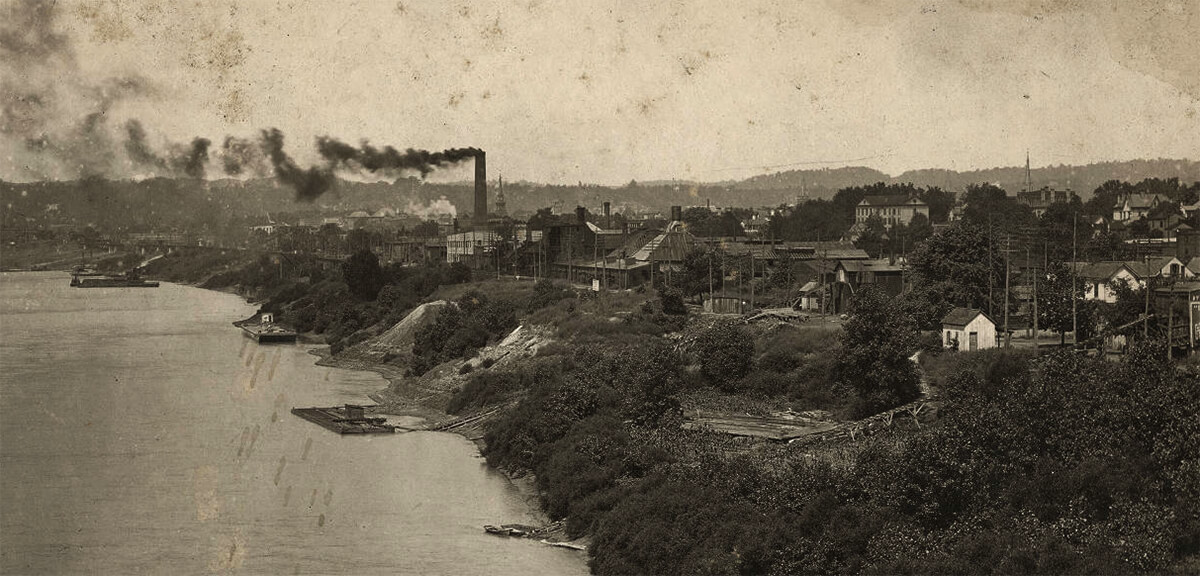
New Albany’s preeminence as a boat building center in the early years of its history gave rise to its later reputation as a city of iron works, for boats needed boilers and engines, and foundries soon sprang up to meet the need. The Morton & Cox Foundry, established on the river front about 1825 by two enterprising partners from Cincinnati, was the first and for many years was probably the only one. But later, as steamboat building grew in importance, the foundry business expanded.
In 1843 the Morton & Cox Foundry was taken over by Lent, South & Shipman and became well-known up and down the river under its trade name of the Phoenix Foundry. One-hundred and 50 men were employed at the Phoenix. Other iron workers found employment at the American Foundry, owned by Peter Tellon, and at the foundry of Phillips, Hise & Co.
But the Civil War, which brought an end to boat building in New Albany, likewise had a profound influence on iron working in the city – an opposite influence. With the end of steamboat building, New Albany capital sought other fields of investment. The experience gained by the foundries in building steamboat engines and boilers, as well as other types of machinery, seemed to point the way. And, as the 1860s drew to a close, the sprawling buildings and smoke-belching stacks along the river front announced that a new industrial day had dawned for the city – the smaller foundries of an earlier day were giving way to the rolling mills and iron works of a new age.
Continue Reading
AS OTHERS SAW NEW ALBANY
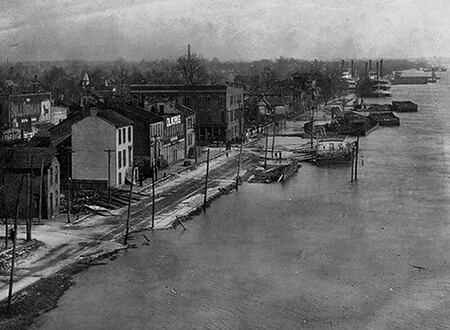
In 1817, when New Albany was only four years old, the struggling village received its first mention in a book of travel. The author, a man named Palmer, wasted no words. “New Albany has been puffed through the Union,” he wrote, describing the advertising the Scribner brothers had placed throughout the country, but added that the town had “not yet realized the expectations of the proprietors.”
The next year the Rev. Isaac Reed, New Albany’s first Presbyterian minister, looked about his new location, then wrote a letter to a friend. “New Albany,” he said, “is now rude in appearance and has few good houses, but it is fast improving.” In 1819 Richard Lee Mason came through town, but wasn’t impressed. He used only thirteen words for his description . . . “Passed through New Albany, a little village inhabited by tavern-keepers and mechanics.”
Continue Reading
LIVE THEATER IN NEW ALBANY
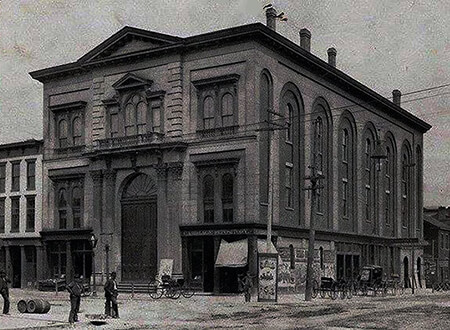
On November 26, 1866 the curtain was raised for the first time at the New Albany Music Hall, ushering in the golden age of the theatre in New Albany. The Music Hall, which became popularly known as the Opera House, seated 2,500 persons and was one of the finest theatres in the entire Middle West. On its ample stage appeared some of the best-known actors and actresses of the Nineteenth Century – dramatic artists who brought delight and entertainment season after season to New Albany audiences.
Continue Reading
BASKETBALL IN THE HOOSIER STATE
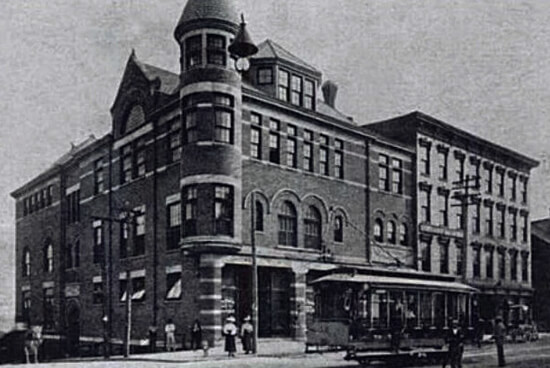
Basketball, a top sport now throughout the Hoosier state, got its start in New Albany at the Y.M.C.A.. The Y.M.C.A. was built in the 1890s at the intersection of Main and Pearl Streets. The old building was torn down in 1954 to make way for a Municipal Parking Lot. The Y.M.C.A. had the first indoor gymnasium in New Albany and soon intramural teams were formed to play the brand new game of basketball which had been developed as an indoor game for winter months when outdoor sports were impossible. Four teams were formed – the Anchors, the Arrows, the Keystones and the Stars.
The new game didn’t attract too much attention in its first years. Then the momentum began to build up. The first New Albany High School basketball team was organized about 1902 and played home games at the Y.M.C.A. It wasn’t a particularly strong aggregation in the early years, and in 1904 lost every game of the season. But in 1906 high school basketball here got a shot in the arm with the completion of the new high school on Spring Street with an indoor gymnasium.
Then the following year the organization of the team as it is managed today came into being. Before 1907 the high school team operated rather independently of the school, playing non-school teams in the Y.M.C.A. League. But that year the captain was suspended from play because of low grades. The team then claimed it was operating as an independent organization and the captain returned to the team. As a result, the School Board took action to put all high school athletics under the direct control of the school – just as it is today.
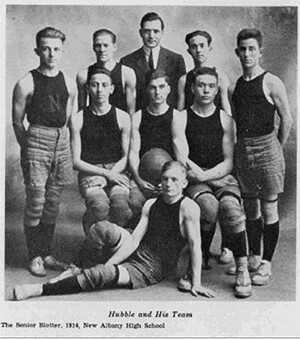
Edwin Hubble coached boy's basketball at New Albany High School for a year. Pictured here is a team from the 1914 season. Edwin's basketball experience included staring as a forward on the University of Chicago Maroons' Big Ten-champion basketball team. Edwin went on to play a crucial role in establishing the fields of extragalactic astronomy and observational cosmology and is regarded as one of the most important astronomers of all time.
Image/Story - NAFC Public Library / Floyd County Historical Society
THE TORNADO
At 3:08 on March 23, 1917 ugly greenish black clouds and tornado winds dropped into the city from over the Knobs.
Within seconds, hundreds of homes were reduced to wreckage.

“Where peaceful, happy homes were and merry children played in carefree glee and where industry was wont to ply its busy wheels, today all is death and destruction and silence.” So reported the New Albany Ledger on March 24, 1917, the day after the tornado struck the city. “Today,” the Ledger continued, “New Albany is plunged in mourning for its dead, prayers for its injured, and compassion for its suffering.”The West Union neighborhood had been the first area of the city hit by the swirling winds. Cherry, Ealy, State and Pearl Streets were a jumble of twisted wreckage. At the Oldham School rescue workers brought out one by one the bodies of youngsters who had been in class when the wind had suddenly transformed the building into a heap of bricks. On Ealy Street eleven bodies were found in the rubble of four adjoining houses.
Continue Reading
THE FLOODS
1937 brought the greatest flood New Albany and the Ohio Valley has ever witnessed – but not the first. The river was the cause of New Albany’s growth – and the river also caused tragedy and destruction . . . the 1937 flood was the climax of a long series of inundations which started when New Albany was less than a dozen years old and continued every few years to plague the city, flooding low-lying areas, forcing riverfront industries to suspend operations, causing thousands of dollars worth of damage to homes and business, and oftentimes claiming lives.
One of the earliest instances of extensive flood damage was in 1832 when the Hughes-Palmer Mill in Clarksville, near the site of the present Pennsylvania Railroad Bridge, was demolished by the raging waters. And in 1847 the old wooden covered bridge which carried Main Street over Falling Run Creek was floated from its moorings and wrecked by flood water.
Unusually severe floods occurred again in 1858 and 1883. Then came the flood of 1884 which for 39 years held the record as the highest ever – until the 1913 flood with its trail of death and destruction seemed to set a mark that would stand as an all-time high. A stone set into the wall of the Pennsylvania Railroad freight station at the foot of State Street records the depth of the 1913 flood. But then came 1937 and all previous marks were literally buried in the mud.
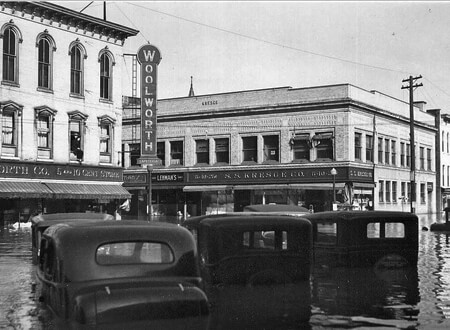
Continue Reading
 The buffalo, which left the Great Plains to visit the salt licks of Kentucky, came through what is now Floyd County and New Albany by the thousands. The trail they made is still plainly visible and was the basis for the first westward road from Louisville to Vincennes.
The buffalo, which left the Great Plains to visit the salt licks of Kentucky, came through what is now Floyd County and New Albany by the thousands. The trail they made is still plainly visible and was the basis for the first westward road from Louisville to Vincennes.








